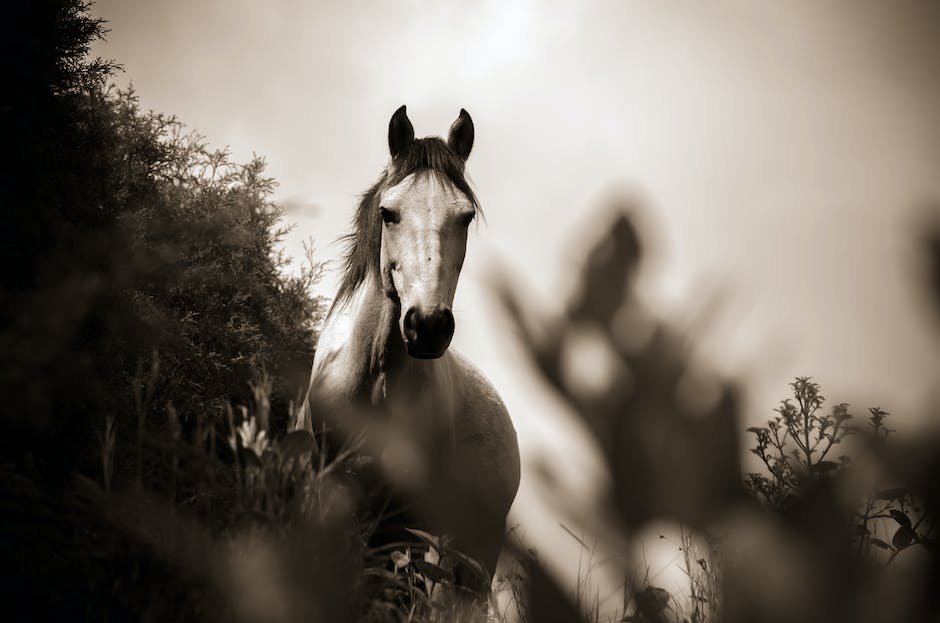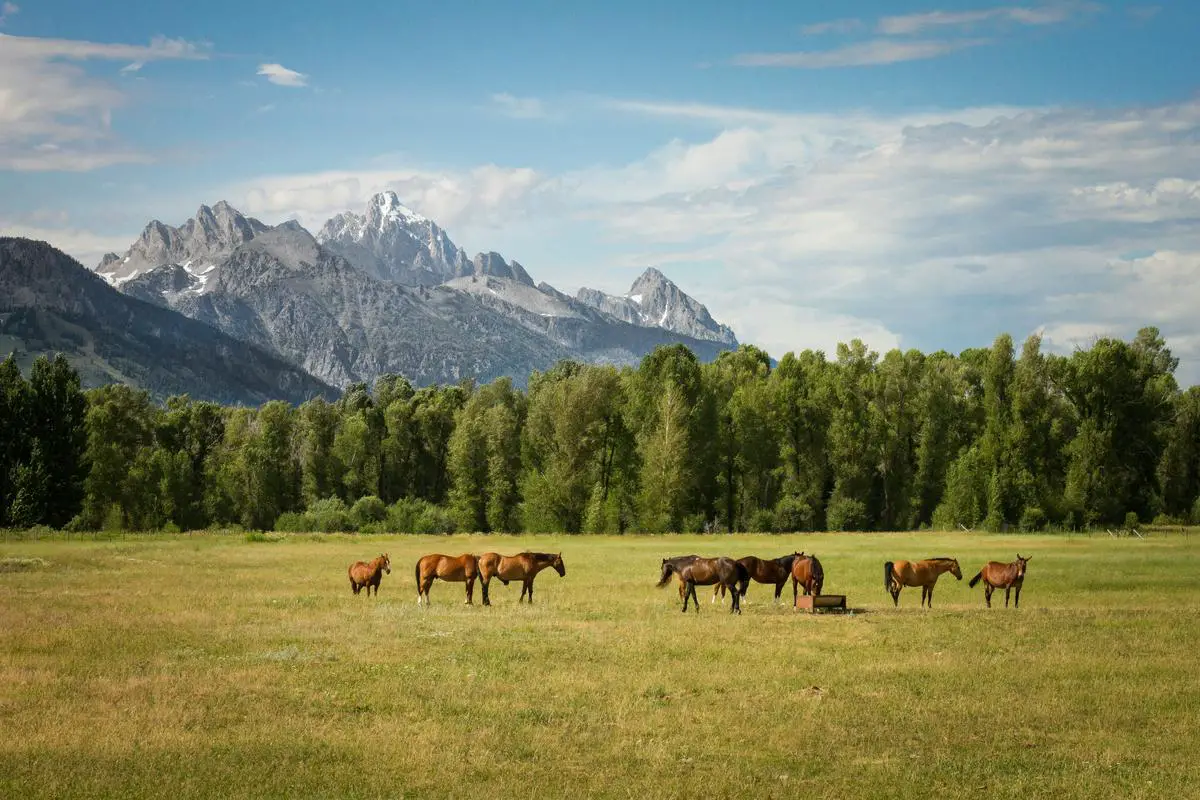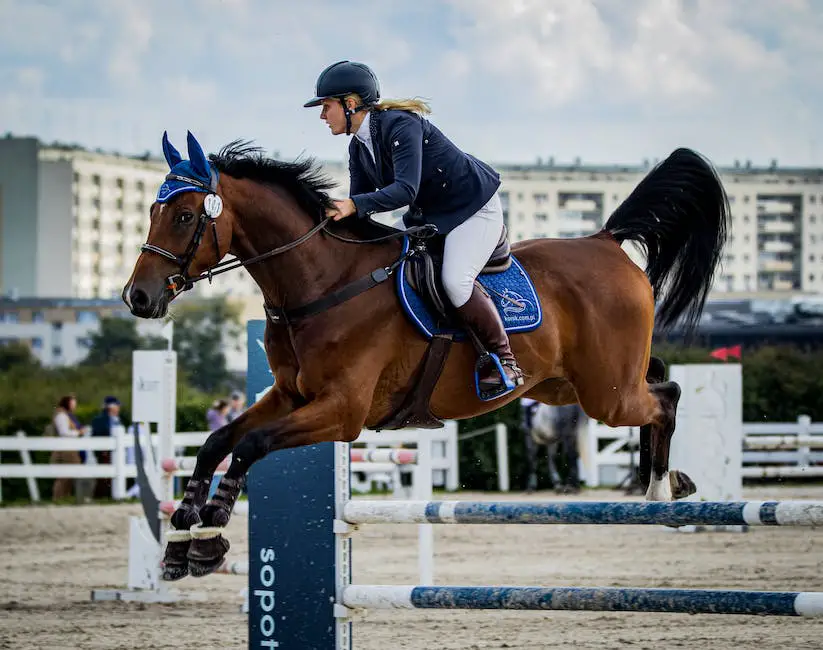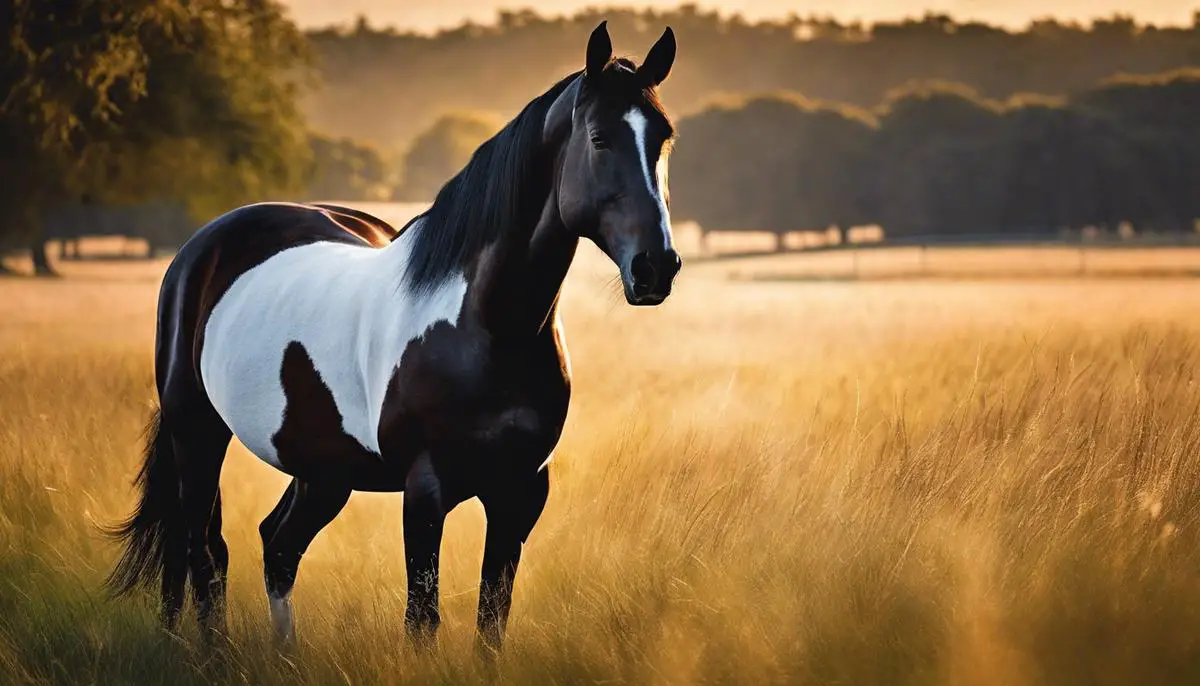Widely known for their stamina, versatility, and exceptional temperament, Warmblood horses harmoniously blend attributes of hot-blooded and cold-blooded breeds, commanding a unique position in the equine world. This harmonious merger of traits has engraved them in the equestrian sports industry, forever changing its landscape. This piece will provide you with a comprehensive overview on Warmblood horses, delving into their rich history, distinct genetic and physical attributes, and varying types that span across the globe. We’ll also take an informative stride into their day-to-day care and specialized training, culminating in understanding their prominent role in various equestrian competitions. Engage yourself in this insightful exploration and let’s delve deeper into the world of these fascinating equine wonders.
Table of Contents (Horspedia)
Understanding Warmblood Horses
There’s magic in understanding the allure of warmblood horses! You can delight in these majestic animals’ breathtaking beauty, entrancing stamina, and extraordinary reliability. They’re not your typical breed, but let’s dive in and explore what truly sets them apart.
Warmblood horses are not your average horses. They are renowned within equestrian circles for their versatility, with many excelling in dressage, jumping, and eventing. Equipped with a unique blend of strength and agility, warmbloods can delicately prance one moment and powerfully catapult the next. This capability derives from their ancestry which traces back to the heavy, powerful “cold bloods” like draught horses, expertly mixed with the speed and stamina of “hot bloods” like Arabians or Thoroughbreds.
It’s fascinating to note that the term ‘warmblood’ identifies a group of middle-weight horse breeds originating from Europe. Warmblood breeds, such as the Dutch Warmblood, Swedish Warmblood, or Hanoverian, are valued throughout the equestrian world. However, despite sharing the ‘warmblood’ title, each breed displays distinct characteristics inherited from their specific ancestral breeding programs. This wide variety hints at the versatility and adaptability of the warmblood classification.
Their physical characteristics are a testament to their mighty performance. Warmbloods feature a larger, sturdier build than hot bloods yet sleeker than their cold blood comrades. They normally stand between 15.2 and 17.3 hands high, presenting an impressive, formidable silhouette. Yet, it’s their locomotion that steals the show. Warmbloods exhibit fluid, smooth movements, peppered with spirited agility that showcases their power and grace.
But the warmblood distinction isn’t purely physical. Warmbloods are well-known for their balanced, even temperament. Typically, these horses are calm, patient, and eager to please, making training and handling a delightful experience. Don’t be fooled, however! While they’re generally mannerly and docile, they also exhibit dynamism, tenacity, and zest making each riding experience unique and thrilling.
Warmblood horses are a living testament to selective breeding with the aim of crafting perfect sport horses. Their exceptional athletic abilities, coupled with their placid temperament, make them ideal competition horses as well as reliable companions.
Indeed, the harmony of vigor, versatility, and serenity converges within the warmblood, casting them as more than just horses. They are dancing athletes, trusted friends, leaping acrobats, patient companions – they are, without a doubt, the harmony in the equestrian world’s melody. If there’s a hobby out there that combines love, pride, and profound respect, it’s the commitment to understanding, nurturing, and appreciating warmblood horses. Their unique qualities not only establish their individuality among horse breeds but stand as a symbol of the wonders that thorough, patient horse breeding can achieve.

Different Types of Warmblood Horses
Exploring the Distinct Types of Warmblood Horses
One of the first things to recognize in the world of warmbloods is the sheer diversity of these majestic creatures. Categorized into various breeds according to their country of origin, each type of warmblood boasts unique traits and characteristics that make them the superstars they are in the equine world.
Starting off our journey worldwide, we land ourselves in Germany – the motherland of popular types like the Hanoverian, Holsteiner, Westphalian, and Oldenburg. These horses echoing German precision, showcase impressive agility and power, making them exceptional performers across multiple equestrian disciplines. Hanoverians, for instance, are highly admired for their strong bodies, intelligent minds, and extraordinary athletic skills. Westphalians and Oldenburgs, alike, stand out with their impeccable movements, courage, and determination in the ring.
Moving westward, we encounter the Dutch Warmblood. Originating from the Netherlands, this particular breed exhibits versatility like none other. Enthusiastically participating in dressage, jumping, and driving, they’re well-known for their keen stamina and friendly disposition. They’re the perfect amalgamation of strength and kindness.
Next is Sweden’s pride – the Swedish Warmblood. Intelligent, brave, and quick learners, these horses are known for their knack for dressage, show jumping, and eventing. Their significant trait is their proud and upright stature, showing off their elegant and rhythmic gaits.
Across the Atlantic now, we stumble upon the American Warmblood. Distinct in their breed, they’re not a mere blend of European warmbloods. Instead, they’re carefully selected and bred for their qualities of courage, athleticism, and temperament. Fully capable of holding their own, American Warmbloods excel in multiple equestrian sports, along with being great companions and top-notch show horses.
A hop, skip, and a jump away, we find ourselves admiring Canada’s equivalent, the Canadian Warmblood. With their roots in European Warmblood stock, they’ve been selectively bred to demonstrate extraordinary stamina, versatile performance abilities, and a calm temperament that many find charming.
Finally, setting foot in France, we come face-to-face with the Selle Francais. Known for their exceptional physical prowess, keen intelligence, and commendable endurance, they truly capture the spirit of warmblood horses’ versatility, making significant names for themselves in show jumping and dressage.
Warmblood horses, with their stunning variety, are a joy to explore and understand. Meeting each breed opens a whole new chapter of knowledge, shedding light on how culture, lineage, and environment play parts in shaping these fantastic equestrians. No matter the breed, every warmblood carries the emblem of grace, power, and harmony that’s so characteristic of their kind- a testament to their intrinsic role in the fascinating world of horses.

Photo by hollymandarich on Unsplash
Care and Training of Warmblood Horses
Training warmblood horses to reach their optimal performance is a fascinating pursuit, a journey of patience, care, and strategic conditioning. These magnificent creatures, blessed with praise-worthy traits, merit an approach that blends knowledge, understanding, respect, and a well-tailored regime. Therefore, getting to know the best practices for training and caring for warmblood horses is essential for both amateurs and experts alike.
An effective training regime should consider the warmblood horse’s genetic aptitudes, their willingness to work and cooperate, and their considerable intelligence and sensitivity. Every training session must entail a series of exercises designed to enhance their inherent abilities, chiefly their knack for Dressage, Jumping, and Eventing disciplines. These exercises must be graduated, building up their strength, flexibility, endurance, and confidence over time.
Patience is indeed a virtue while training these horses. One should ensure that the horsey’s growth, development, and maturity are not rushed. Gently introducing them to new concepts, sights, sounds, and environments makes the learning process less traumatic and more effective. After all, a warmblood horse’s well-being is connected not only to its physical health but also its mental state. An anxious or stressed horse may struggle to perform to the best of its ability, no matter how excellently it has been trained.
Equally important to the training regime is a comprehensive, high-quality nutrition plan that fuels these athletes’ demanding schedules. A proper diet for a warmblood horse must contain adequate amounts of hay, grains, and various supplements to keep them healthy and energetic. Controlled access to quality pasture offers both physical exercise and mental relaxation for the horses.
Beyond training and feeding, it’s necessary to maintain a regular grooming routine. Cleanliness is pivotal in preventing infections and diseases. Additionally, grooming enhances the bonding between the handler and the horse, strengthening the trust and respect that is crucial for successful training. A well-groomed horse is often a happy horse, and a happy horse is more likely to be a high-performing one.
Moreover, regular veterinary check-ups are of utmost importance while nurturing these warmbloods. Renowned for their robust build and enduring performance, these horses are not devoid of potential health issues. Routine check-ups help identify any potential problems early on, from minor infections to significant concerns like arthritis or laminitis. Besides, an experienced equine vet can provide valuable advice on effective training and care regimes based on the individual horse’s age, overall health profile, and competitive level.
Lastly, treat your Warmblood horse with respect, understanding and include generous amounts of love – because they are not just any horse, but also a reliable companion. An emotional bond between the handler and the horse affects the horse’s mental state, which in turn can highly influence its performance. Therefore, the process of caring for and training a warmblood horse is more than a sum of the tasks mentioned above. It’s truly an enriching journey of mutual respect, shared aspirations, and long-lasting partnership en route to optimal performance.

Warmblood Horse Competitions
Delving into the illustrious world of warmblood competitions, it’s clear that these events are more than mere shows of horse acrobatics. They are significant milestones in the equestrian journey and have an enormous impact on their prestige in the equestrian world. High-profile competitions like the World Equestrian Games, the Olympics, and the European Championships hold immense sway and are considered the pinnacle of achievement for warmblood horses worldwide. They showcase the captivating beauty, vigor, skill, and versatility of these horses in various disciplines, such as dressage, show-jumping, and eventing.
Notably, warmbloods regularly garner top accolades in these prestigious competitions, not only for their exceptional physical prowess but also for their unrivaled intellectual capacities. The vitality, elegance, and precision shown during dressage; the innate sense of timing and scope in show-jumping; and the admirable courage, agility, and stamina in eventing are all evidently visible, empowering the warmbloods to dominate these competitions.
Closer home, warmbloods thrive in the United States Equestrian Federation (USEF) championships, vying for the coveted top spots. These championships serve as significant launching pads for these equine athletes, as they not only offer national recognition, but they also open doors for potential participation in international competitions.
In Europe, warmbloods are traditionally bred for competitive excellence, so European shows like Aachen, Hickstead, and Spruce Meadows are often graced by warmblood horses of various breeds such as the Hanoverian, Holsteiner, Oldenburg, and Dutch Warmblood. These events not only celebrate the success of warmblood horses but they also encourage breeders to continue their breeding programs to maintain this high standard.
Exclusively for the warmbloods, dedicated sport horse breed registries organize annual inspections, shows, and performance tests such as the Hanoverian Society, Oldenburg Horse Breeders’ Society, and Verband der Züchter des Holsteiner Pferdes, among many others. These events provide invaluable insights into the growth, development, and potential of young warmblood horses for breeders, trainers, and prospective buyers.
The role of these horses in these competitions cannot be downplayed. Their participation doesn’t just symbolize a conquest of individual events but a testament to the commendable lineage, superior training, optimum care, and the collective contribution of breeders, trainers, and riders in honing these majestic creatures.
Not to mention, these competitions play a crucial role in elevating the stature of Warmblood horses in the horse world, validating their reputation as the crème de la crème of sports horses. The attention drawn by these competitions sparks interests among the layman, kindling a newfound appreciation and understanding of warmblood horses and their immense value within equestrianism.
Beyond the ribbons, trophies, and glory, the heart of these competitions lies in fostering a culture of excellence among warmbloods, setting high standards of performance, and endorsing the paradigm of warmbloods as paragons of competitive sports horses. Ultimately, the footprint left by warmbloods in these competitions continues to etch deep and lasting impressions in the sand of the equestrian world.

The delicate balance of power, grace and temperament that warmblood horses exude results from careful breeding spanning centuries, concerted nurturing, and adaptive specialised training. Through exploring the various types of warmblood horses, the unique attributes that have each breed stand out, the essential care and training requirements, we gain a profound appreciation of these remarkable creatures. As we witness them within the equestrian spheres, gracefully commanding attention in dressage, exhibiting raw power in show-jumping and demonstrating unmatched fortitude in eventing, it is undeniable that the warmblood horse epitomises the ideal blend of strength, agility, and finesse. Such is the magnificence of Warmblood horses.

